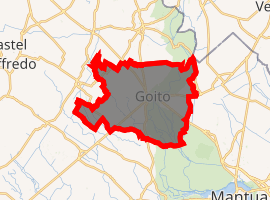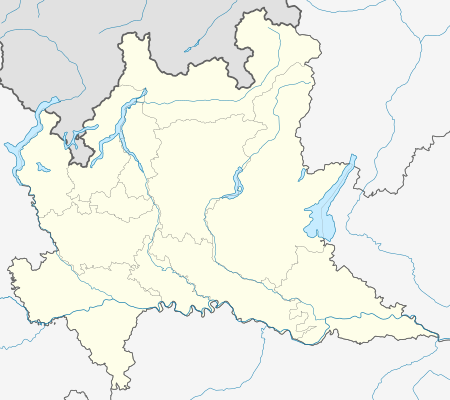Goito
Goito (Upper Mantovano: Gùit) is a comune of Lombardy, northern Italy, part of the Province of Mantua, from which it is some 20 kilometres (12 mi), on the road to Brescia. It is on the right bank of the Mincio River near the bridge. The town is part of the region known as Alto Mantovano (Upper Mantuan).
Goito | |
|---|---|
| Comune di Goito | |
Fight between Austrians and Piedmontese over the Mincio bridge in Goito on 8 April 1848 | |
 Coat of arms | |
Location of Goito 
| |
 Goito Location of Goito in Italy  Goito Goito (Lombardy) | |
| Coordinates: 45°15′N 10°40′E | |
| Country | Italy |
| Region | Lombardy |
| Province | Mantua (MN) |
| Frazioni | Ca' diciotto, Calliera, Cerlongo, Maglio, Massimbona, Maioli, Marsiletti, Sacca, San Lorenzo, Solarolo, Torre, Vasto |
| Government | |
| • Mayor | Pietro Chiaventi |
| Area | |
| • Total | 79.22 km2 (30.59 sq mi) |
| Elevation | 33 m (108 ft) |
| Population | |
| • Total | 10,289 |
| • Density | 130/km2 (340/sq mi) |
| Demonym(s) | Goitesi |
| Time zone | UTC+1 (CET) |
| • Summer (DST) | UTC+2 (CEST) |
| Postal code | 46044 |
| Dialing code | 0376 |
| Patron saint | St. Peter and Paul |
| Saint day | June 29 |
| Website | Official website |
History
It was founded as a Roman colony in the early 2nd century BC as a defensive outpost on the Mincio crossing along the Via Postumia from Cremona to Verona. In the late 5th century AD, after the fall of the Western Roman Empire, it became a fortress of the Ostrogoths, from whom the current name perhaps derives. Later it was conquered by the Lombards and the Franks.
In the later Middle Ages it was held by the Canossa family as part of the Holy Roman Empire, and then it established itself as a free commune. In the 15th century Goito was contended between the Visconti and Gonzaga families, until, after a battle fought on 14 June 1453, it became a possession of marquis Ludovico III Gonzaga. He built here a residence (in which the painter Andrea Mantegna worked in 1463–64), restored the fortifications and built the Naviglio di Goito canal, and died here by plague in 1478. Goito maintained its prosperity under dukes Guglielmo and Vincenzo I Gonzaga.
After the decline of the Gonzaga lordship, and struck by an earthquake on 5 July 1693, in 1708 it was annexed to the Austrian-held Duchy of Milan. In the late 18th century it was captured by the French and later retaken by the Austrians. During the First Italian War of Independence, the Piedmontese forces won two actions (8 April and 30 May 1848, called the battle of Goito) over the Austrians here.
It became part of Italy after the Second Italian War of Independence.
Twin towns
Goito is twinned with:

References
- "Superficie di Comuni Province e Regioni italiane al 9 ottobre 2011". Istat. Retrieved 16 March 2019.
- Data from Istat
- "Popolazione Residente al 1° Gennaio 2018". Istat. Retrieved 16 March 2019.
Sources
![]()